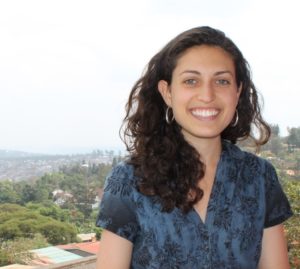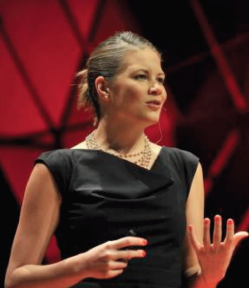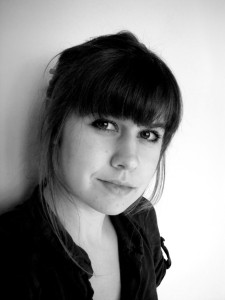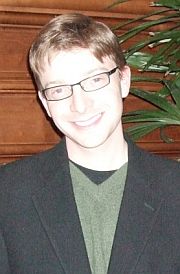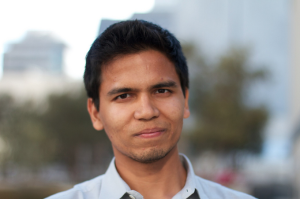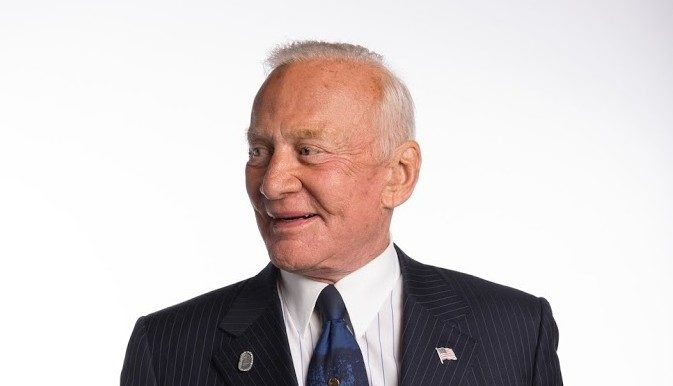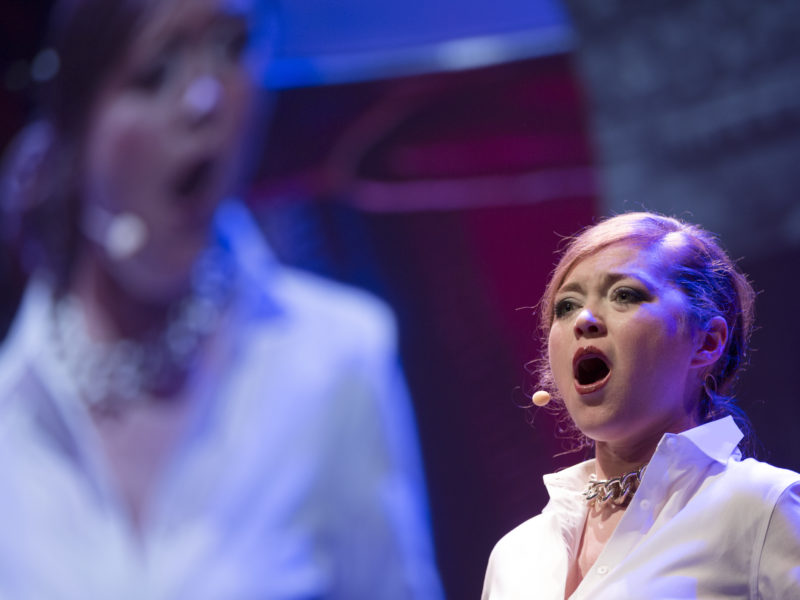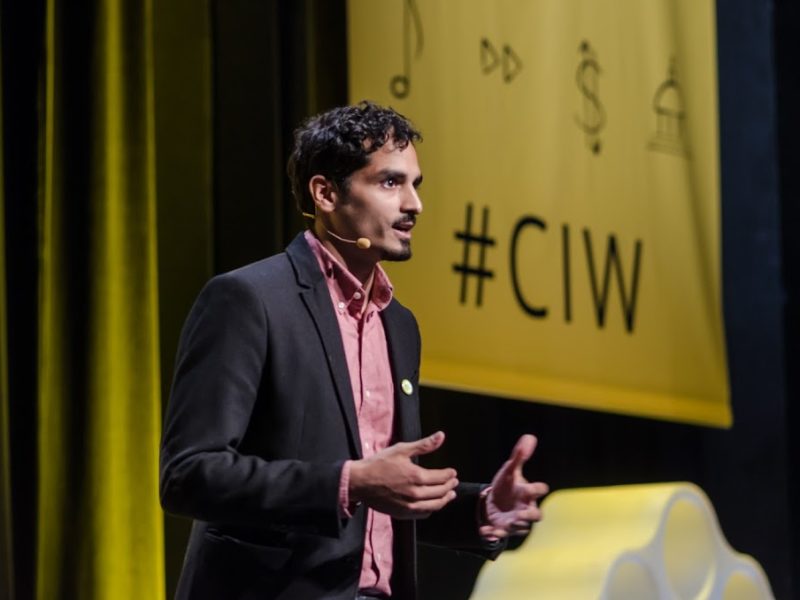
Get to Know Our 2013 BHSI Fellows
So you know their names, but who are these 2013 Bluhm/Helfand Social Innovation Fellows?
In addition to getting $10,000, these five young social entrepreneurs will speak at CIW in October and have incredible access to world-renowned business leaders.
Sasha Fisher, 25
How did a visit to South Sudan give birth to the idea of microgranting development projects in Africa?
I was there because I believed the world could rebuild South Sudan with schools, health centers and businesses – and this was the time to do it. But when I visited projects in the area I saw schools lying empty.
I asked village members why this was when we were standing in a region that faced one of the lowest access rates to education in the entire world. People told me it was because locals were not involved in the project planning, and therefore didn’t have ownership over its success. Village members were waiting for outsiders to come in and run the schools for them.
I learned that aid projects driven from the outside are often unsuccessful and unsustainable – not because of the type of projects they are, but because of how they are established.
What motivated you to move to Rwanda and start Spark MicroGrants after graduating college?
I was – and still am – fed up that more than a billion people living on our shared planet cannot meet their most basic human needs. I wanted to know how to support rural poor communities to drive their own development through an approach that could be used not just in one or two communities, but in millions around our world.
I co-founded Spark MicroGrants to pioneer a new approach to global aid that provides funding and facilitation directly to communities facing poverty. With a bottom-up approach, village members can design their own futures and build needed projects like health centers, farms or schools.
Break down for us how your organization works. How are you different from other crowdfunding platforms, like Kickstarter?
Many of us want to support local projects abroad – we know that small amounts of money can go extremely far in communities facing poverty. Spark MicroGrant’s website provides the only place online where anyone can invest in a locally-designed and locally-run project abroad and receive direct updates from the field. Every community on Spark’s website has gone through our intensive five-month project planning process and will receive our follow-up program as well – ensuring donors that their money is being channeled into a sustainable, needed project.
What impact have you made so far?
Spark has worked with 55 communities across Rwanda and Uganda, impacting more than 20,000 lives. More than 60 percent of communities we have worked with have already gone on to grow their initial project or launch a second – and sometimes even a third – impact project.
What big idea do you want to share with the world?
Local, community solutions work. It’s so simple and it will work anywhere: Give communities the capacity and resources they need to drive local change, and we’ll see healthier, happier communities in the future.
Must be nice to have a check for $10,000. What awesome things will you do with the money?
Absolutely! Every $5,000 we raise lets us work with a new community, impacting 120 families on average. We’ll use the funding to work with one new community in Rwanda and one new community in Uganda, enabling both to start a project they have wanted for years.
Where do you see Spark MicroGrants in five years, and how will BHSI help you get there?
In five years we expect to work in five countries with a 200-community annual reach and a training program for individuals and organizations that want to utilize the microgrant model in their regions of focus. BHSI will enable us to invest in growth and build substantial private, public and citizen partnerships so we grow as an organization and grow the movement for local, community-led development.
What keeps you going when you wake up every morning?
Supporting others to generate change is addictive. If you haven’t tried it yet, go to Sparkmicrogrants.org and get involved!
What are you most excited about for Chicago Ideas Week 2013? Why?
Meeting the other incredible BHSI fellows, having the chance to talk to company and movement leaders and of course building the movement for local, community-led development!
Sarah Elizabeth Ippel, 32
How did your childhood education and international travel inspire you to start the Academy for Global Citizenship (AGC)?
After growing up in the Midwest and learning through a rather conventional educational framework, I chose to pursue graduate studies in England. I immediately grew fascinated by the cultural variances among my new international peers and was curious to understand how they may have learned differently in their respective countries. To take breaks from writing my dissertation, I… began visiting schools in nearby countries. And what began as curious extended weekend jaunts with a backpack evolved into a determined quest to study international education systems across six continents. While traversing the world, from Laotian hillside villages to rural Senegalese communities, I was welcomed into classrooms in more than 80 countries to observe how children learn.
After witnessing the tremendous disparities that exist internationally with regards to heath, education and the environment – and upon moving to Chicago – I realized that these very inequities existed within my own backyard. I was beginning to feel an urgent sense of concern for the state of our planet and future. This ignited within me a passion to address all three issues by creating an educational model that comprehensively integrates community development strategies to support positive nutrition and ecologically sustainable practices rooted in a solid academic framework.
When I was 23, I rode my bicycle to the Board of Education with a dream to reimagine what is possible in public education today. Three years later, the Academy for Global Citizenship (AGC) opened its doors on Chicago’s underserved southwest side in a former dental tool factory.
How is AGC different from many Chicago Public Schools (CPS), and how is CPS trying to implement your ideas?
As an authorized International Baccalaureate (IB) School, AGC’s innovative curriculum prepares students to be mindful, civically engaged leaders by examining and realizing their role in both their local communities and in the world.
This is achieved through an experiential, student-centered program focused on taking action in the world as result of learning, rather than simply acquiring academic knowledge. For example, students learn math by charting outcomes from our solar energy learning lab in the schoolyard garden, literacy by drafting a business plan for their next entrepreneurial endeavor and science by inventing new applications for emerging clean technologies . . . starting in Kindergarten.
An AGC education extends beyond a solid academic foundation and ultimately prepares students with the necessary skills to apply their knowledge in a societally significant way. Organic, nutritionally balanced meals, daily yoga, gardening, wellness instruction and ecologically sustainable practices throughout the school encourage learners to develop healthy and sustainable lifestyles for themselves.
You have an amazing goal to impact 20 million students by 2020 – how will BHSI help you reach that?
Yes, we’ve got some exciting plans in the works as an extension of the Academy for Global Citizenship’s vision to be a “learning laboratory” and incubator for scalable innovation. As we embark on the “next chapter” to launch this national platform, it is my hope that my participation in the Bluhm/Helfand Social Innovation Fellowship will provide opportunities for engagement with key advisors, civic leaders, philanthropic supporters and strategic partners. Inspired by my co-fellowship colleagues, I look forward to our discourse on current issues facing the social innovation, education and entrepreneurship sectors in addition to building cross-sector relationships.
What awesome things will you do with the fellowship money?
As we approach the cusp of significant organizational growth, I’m committed to both broadening my leadership skills and I’m excited to pursue professional development opportunities that our limited budget would not otherwise support. Furthermore, I have derived value from representing the United States as a Delegate to the G8 Young Global Leaders Summit over the past two terms and anticipate this honorarium will enable my participation in Moscow in 2014. In addition to enhance my leadership skills, these opportunities would allow me to collaborate with social innovators from across the globe to further our vision for transforming education.
What is the most powerful moment you’ve witnessed from AGC?
I am most struck by the ways in which our students take their learning into their homes, communities and the world. Consistently, we have parents walking through our doors with stories of how their child has inspired healthier eating habits in their home… how their entire family has connected through planting a vegetable garden and even a 2nd grade student who launched a “triple bottom line” business to foster sustainability in his community.
Once built, the AGC campus will be the first net-positive energy building in Illinois. Why is that so important?
We’re producing a replicable model for learning in the 21st century, including the construction of a net-positive energy campus which will produce more energy than is consumed annually through on-site renewable energy. Over the next 40 years, the number of people living in cities is projected to double to 6 billion. As such, it is imperative that we develop thoughtful, long-term-oriented and replicable models for efficient water, power and food solutions in our communities. The campus will incorporate several acres of restorative urban agriculture and food production, including a native tree forest, vegetable gardens, orchards and greenhouses – which will serve as a “third teacher” for sustainability education as well as providing positive foods to our local community.
You say that Midwestern values are integrated into every aspect of AGC. What about the Midwest and Chicago will help AGC succeed?
Chicago is home to a myriad of industries and leaders representing areas critical to AGC’s success; few other cities have such a multifarious combination of high tech, manufacturing, banking, strong academic institutions and civic engagement. Chicago’s robust corporate, philanthropic and social innovation communities provide an ideal environment for launching entrepreneurial initiatives, which will be essential for the development of our net-positive energy campus and future vision.
What can people do to live more environmentally-conscious lives?
At AGC, we have seen how an entire movement can be ignited by a single step – whether it’s shopping more regularly at your local farmer’s market, purchasing more efficient light bulbs next time they need replacement, or choosing to ride your bike instead driving once a week. If you’re in need of some inspiration, come visit the Academy for Global Citizenship and ask one of our Kindergarteners about how much fun we have raising chickens, growing asparagus and sharing food scraps from our zero-waste cafeteria with our vermicompost (worm) bins!
What are you most excited about for Chicago Ideas Week 2013? Why?
Having participated in Chicago Ideas Week over the past two years, I am a fervent fan and am very much looking forward to year three! I am most excited about participating in the Bluhm/Helfand Social Innovation Fellowship and discussing “big ideas” with cross-sectorial leaders. Together with members from the CIW community, we have such tremendous capacity to achieve great things in Chicago and beyond.
Caitria O’Neill, 24
Recovers grew from the rubble of a freak natural disaster – tell us about the tornado and when the idea for Recovers came to you.
I was standing in the front yard when the tornado came over the hill. A lamp post flew by, at which point I realized I needed to get into the basement. After sheltering for a few minutes, I moved to the back door and watched the storm scrape up the valley. It was then, watching the twister tear through the neighborhoods I had grown up in, that I realized how much damage we would be facing.
I got involved in recovery as a local aid coordinator after visiting the First Church of Monson and realizing that no one knew where to send all of the folks showing up to volunteer or drop off donation items. It was a building full of resources, surrounded by unthinkable damage, with no one connecting the two.
My sister Morgan and I built that connection using a mash up of web tools, paper systems and willpower. It was during the first week of organization that it occurred to me that what we were doing in Monson was not innovative. In every community, after every disaster, someone builds a system to do what we were doing. And because they are not disaster recovery experts, they build a system with flaws and holes that are only realized later in recovery. I thought of taking the grassroots organizational system that was working for Monson and jamming it into software in order to transfer best practices to communities across the country.
Break down what Recovers does .
Our software connects local leaders with local resources, helping them meet survivor needs. Volunteers and people who would like to donate physical items can find local organizations that need their specific assistance, sign up remotely, receive updates from local leaders and change their availability. Disaster survivors can request assistance through SMS or our web platform, or view updates on aid and the locations of distribution centers. Local leaders can manage volunteers, donation items and requests for help throughout response and long-term recovery.
How will BHSI help you meet your goal of implementing Recovers before disasters strike?
We hope to refine our business plan under the tutelage of the BHSI team, program mentors and other members of the cohort. We’ve had success with sales to many different types of organizations. We’d like to narrow that focus and perfect our messaging and outreach strategies.
Must be nice to have an extra $10,000 in your pocket – What awesome things will you do with the fellowship money?
We will put the funds directly toward travel to disaster-stricken areas. We launch our software for free following disasters in order to help survivors and organizers, test our product and make improvements and create more awareness of community recovery efforts in the U.S. and abroad.
We love happy endings. You’ve said your hometown of Monson, Mass., has recovered from the tornado more empowered than ever before. What are some other touching success stories you’ve had?
The organizational system we created in Monson split into two different organizations, which are still active and helping survivors recover to this day. The first is the Monson Tornado Volunteers group that coordinated debris removal and home repair efforts. The second was a group called Street Angel, devoted to checking in on survivors and bringing welcome home baskets to those returning to repaired properties.
What is the No. 1 mistake people make when reacting to a disaster, and what should they do instead?
People automatically assume that survivors will need whatever they have on hand and want to get rid of. Instead of bringing what you think will be needed (ahem, ‘80s jumpsuits, dirty mattresses, cat T-shirts), please wait until you hear from local organizers about what they need. Here are some things that will always be needed in every type of disaster everywhere: gift cards to local home goods stores, home improvement supply stores, gas stations and restaurants; leather-palmed work gloves; heavy-duty trash bags and large storage containers
You started the company with your sister, Morgan. How has your relationship grown?
Oh man. Growing up as a younger sister, my suggestions for games or movies were often met with, “You’re not the boss of me.” As our present CEO, I am the boss of her. And it feels great.
More seriously, we really bonded during Monson’s recovery. We knew each other so well that we could completely trust the other person to make important decisions and speak for the both of us. We also could speak in sibling-shorthand and keep meetings really brief. I don’t think either one of us could have handled the 15 hour days and responsibility of Monson’s recovery alone.
How did you respond to people who doubted you because of your youth?
[Laughs] When I’m sweaty and wearing a Monson High School T-shirt, I look about 14 years old. People take orders and advice from me because I’m usually the only one telling them what to do. I figure someone has to make decisions – why not me?
I build credibility by speaking about my experiences in recovering areas across the country. Our work doesn’t depend upon popularity, it depends upon trust. I build trust by saying I’ve been the survivor, I’ve been the responder and I also feel responsible for preparing your community for a big storm. We’re on the same page.
What are you most excited about for Chicago Ideas Week 2013? Why?
I’m equally excited about the mentorship we’ll receive from the team/mentors/other Fellows, and the idea to share our work in a presentation to the awesome folks who come to Ideas Week. I love telling stories about our work, the growing movement of community-powered recovery and encouraging people to keep showing up until “officials” take them seriously.
Andrew Mangino, 26
You went from studying at Yale to writing speeches for Vice President Joe Biden and Attorney General Eric Holder to a becoming a senior entrepreneur at Ashoka. How did that path lead you to found The Future Project?
Every step along the way, I had been working with—and telling stories about—young people in schools from New Haven to Newark to Washington, D.C., and I had been—almost without fail—at once inspired by their incredible stories and incredible dreams but also fed up that education in this country did not make it a priority to nurture that stories and to power those dreams. And when I learned about the framework of the social entrepreneur, I knew I had found my calling. It struck me and our brilliant co-founder, Kanya, that nothing would change unless we stopped waiting for permission and did something about it—a message I had been learning about, writing about and pushing out for the previous half decade – but then I realized I had the chance to put something great into action myself.
How does the organization transform high school students into passionate leaders?
It starts with our Dream Directors, who are part human catalysts, part social imagineers and part unstoppable entrepreneurs. We recruit the most inspiring and motivated people we can find nationwide, and we embed them into high schools with whom we partner. They then go into the school—not to impose, but to listen and learn and really hearthe dreams, ideas and passions of the student body and faculty. And they recruit student fellows, who learn how to become Dream Directors themselves, thus distributing the leadership across grades. With all this in place, the magic all begins as Dream Directors work with students 1:1, in small groups and as a community-wide movement to define their boldest dreams and help them see what they can do, right now, to change the world. Throughout the school, students begin taking on their own projects—until the school becomes a vibrant and inspired hub of action and ideas.
Sounds great – What impressive stats can you share to show just how deep of an impact you’re making?
In only two years we have seen hundreds of Dreamers come to life, launching more than 400 Future Projects across three cities and taking collectively tens of thousands of actions over many thousands of hours. In some schools, we’re finding, attendance has skyrocketed among those students involved in The Future Project and graduation rates have increased.
But success to us is best captured in the fact that so many students have taken the first step toward making their dreams reality. Once you figure out you can do that once—and how—you do it forever.
What big idea do you want to share with the world?
The big idea I want to share with the world is that, as Eleanor Roosevelt said, the future belongs to those who believe in the beauty of their dreams, and so there is nothing more important we can be doing for the future generation than inspiring them to believe in the beauty of theirs. It’s a modern tragedy that millions of young people everywhere do not walk away from school with conviction that their dreams are worth it. If we focused on solving that problem—and only that – everything in this world would start to change.
Tell us about the scenario where you were censored—but you fought and won—during an investigation of the state of sexual education in your suburban New Jersey community. How did it spark your passion for community organizing?
When my high school principal censored our newspaper, The Caldron, I learned the best lesson of my life: that people are ready to fight for what they believe in and do unreasonable, bold things when they are asked to serve.
Hundreds of my peers—and many former editors of the newspaper, as well as my adviser—joined the quest to eliminate censorship in my school. It was both exhilarating and magical to see them line up and experience how much stronger we were when we banded together. When we ultimately succeeded, I was convinced that there is no more potent form of political power in the world than when passionate people who want to see a common change commit to making it happen—and do whatever peaceful thing it takes to succeed. And I still am.
Must be nice to have an extra $10,000 in your pocket. What awesome things will you do with the fellowship money?
There’s only one thing I truly care about: getting what we do to make an impact right—and up to “Apple”-level quality standards. And so even as we prepare to expand nationwide, I’m most excited about applying our funding to perfecting our Dream Director model so that we can see tens of thousands of Dream Directors in the world transforming all the schools in America by leveraging the greatness already within their walls.
Where do you see The Future Project in five years, and how will BHSI help you get there?
Our commitment is for every under-served high school in the nation has a full-time Dream Director, and a model that ensures every single student in that school gets whatever it takes before they leave it to grasp their own greatness for the rest of their life. That would change everything—hundreds of thousands of student-driven and passion-inspired projects will have been born and schools will be some of the most inspired places on earth.
BHSI will help us get there in a huge way, for it’s a “public debut” of sorts for us, a chance to connect with people and organizations who—whether or not they describe themselves this way—specialize in inspiring and supporting big dreams until they come to life.
What keeps you going when you wake up every morning?
As a speechwriter, I love quotes. For mornings, I especially love Howard Thurman’s charge: “Don’t ask what the world needs. Ask what makes you come alive, and go do it. Because what the world needs is people who have come alive.” When I remind myself I’m fighting for a world in which people give themselves permission to come fully alive, I know it’s time to wake up—and do the same—myself. The other thing that keeps me going—more tangibly—is the team that has formed around The Future Project. They are unbelievably committed to their core, constantly challenging me, full of passion—and many of them have made many sacrifices to devote themselves to The Future Project. It’s incredible to feel so supported every single day by a team of nearly 30 amazing people committed to a renaissance in America!
Who is John Williams and why should everyone listen his magical compositions?
John Williams is the most magical man on earth, the composer of the greatest film scores and musical motifs of the past half-century—such as JAWS, Jurassic Park, Indiana Jones, and ET to the NBC Nightly News mission, Star Wars, Harry Potter, the Olympic fanfare and Schindler’s List. I have long been convinced that he’s the source of all inspiration in the world. And so anyone in need of a boost of energy—musical proof that anything is, in fact, possible in the world—must stop whatever they are doing right now and listen to a John Williams fanfare. You will never be the same again.
Vineet Singal, 23
How did a personal challenge to overcome Type II diabetes and lose 80 pounds turn into a mission to improve healthcare for low-income patients?
When I was young, I was always a little chubby. But lack of exercise, a genetic tendency to gain weight and delayed puberty meant rich fodder for jokes that got crueler as childhood progressed to adolescence. Coping became a strategy born out of necessity. I vividly recall being physically and verbally harassed for being obese, wearing glasses and having an Indian accent at the all-boys high school I attended in New Zealand. At one point I remember one of the bullies remarking, in front of the entire class, “Show us your cleavage.” I felt so humiliated that I never told my parents. When I came to Stanford, I decided that I had to face this challenge and not let my obesity get in the way of living my life. I urged my freshman year roommate to work out with me every single day. I worked with Stanford nutritionists to set up a strict diet plan. My motto became “Impossible is nothing”. Eventually, after two years of constant, unyielding struggle, I reached my goal; I was 75 pounds lighter.
I realized that although I lived in these diverse backgrounds and battled many challenges – bullying, racism, obesity and depression – I did benefit from the wealth of kindness this world has to offer. I gained an unyielding belief that no matter our differences, the things that unite us and bring us together are stronger and far outnumber those that drive us apart. As a sane, able-bodied, healthy, educated male living in a world rife with poverty, homelessness and disease, I felt a compelling responsibility to take action.
I decided to take a leave of absence from Stanford to volunteer fulltime at a free, post-hurricane clinic in Galveston, Texas. I cannot forget the countless patients who I saw suffer from amputations, blindness and renal and heart failure because of their diabetes or hypertension. I helped them through their illnesses, seeing a little bit of my own struggle in their stories, motivating them by sharing my own battles with the same issues.
When I returned to Stanford, my experience at St. Vincent’s continued to challenge me to do something for low-income patients all over America.
What motivated you to turn down a scholarship to a top-tier medical school to become Anjna’s full-time CEO?
I believe the true mark of entrepreneurs is their ability to never give up. I conceived of the idea for Anjna back in early 2011. And for the course of a year and a half, I struggled to find significant funding and traction. There were countless times where I was on calls and meetings with potential donors who said that they weren’t convinced in our vision and path. These failures were, in my opinion, the most important periods for us as an organization and for me as a social entrepreneur. As graduation neared, I decided that although I eventually wanted to become a physician, what was important to me was to be able to pursue a vision so close to my heart. I decided to turn down a full scholarship to medical school to run and grow Anjna.
Break it down for us – What does Anjna Patient Education do?
Anjna provides underserved patients with the support they need in order to lead healthier lives. Anjna developed intuitive technology that lets nurse practitioners, case managers and care coordinators in low-income clinics and community health centers connect with their patients outside the clinic. We worked with experts in behavioral psychology and clinical medicine to design actionable, customized and culturally relevant health education in multiple languages.
Patients started missing fewer appointments. They attended more health education events. They got better about taking their medicine and tracking their glucose levels. Health literacy shot up and they learned how to self-manage their conditions.
Our goal is to improve health outcomes and reduce overall healthcare costs.
Tell us about the impact you’ve made.
We have conducted effective needs assessment research on the lack of ongoing patient management and educational support for the underserved in the United States. We developed and tested our proprietary web and mobile-based application, leveraging SMS-based technology tools to provide ongoing support to underserved patients. We’ve created and tested SMS-based health education content, targeting high risk/high cost patients with obesity, Type 2 diabetes, hypertension and hypercholestrerimia/hyperlipidemia.
What big idea do you want to share with the world?
As the national spotlight focuses on the healthcare crisis, one group remains in the shadows, left behind and underserved. They don’t understand how the system works and don’t get the care they need. They are members of the lowest socioeconomic groups who are most at risk for costly chronic, preventable diseases like Type 2 diabetes, hypertension and hyperlipidemia. I believe we can make a massive difference in healthcare for low-income patients in the United States and globally.
Where do you see Anjna in five years, and how will BHSI help you get there?
Our long-term vision is to create a suite of communication tools beyond SMS (smartphone apps, email, etc.) that can enable meaningful conversations with patients. This not only helps increase patient engagement and accountability, it has a second order benefit of reducing overall costs to the healthcare system.
What are you most excited about for Chicago Ideas Week 2013? Why?
To brainstorm ideas and create communities to implement solutions that furthers the collective good, with the help of some of the smartest and most passionate people in the world.
Q&As are edited for clarity and length.


